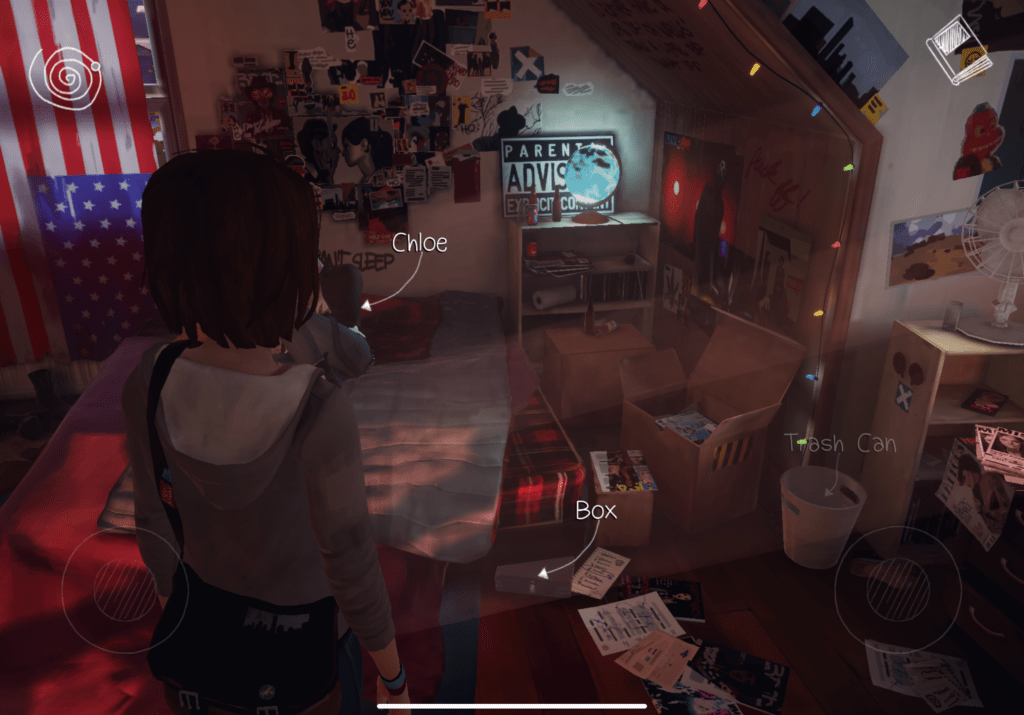In “Life Is Strange,” the player is prompted to gather information about objects and people and traverse loops of story through the “time rewind” ability. These two key mechanics push the player to constantly explore different possibilities of the past, present, and future of the narrative’s mystery and experience the aesthetics of discovery and challenge.
“Life Is Strange” is an adventure game developed by Dontnod Entertainment and published by Square Enix. It is available on PlayStation, Windows, Xbox, iOS, Android, Nintendo Switch, etc. I played it using an iPad Pro.
The game’s setting constantly pushes the player to observe objects and people, unlocking more information about character relationships, situations, and memories, leading to the aesthetics of discovery. Starting from the first scene, Max (the protagonist controlled by player) could observe many items and people around her. In the game, these options are highlighted by white arrows, which are extremely obvious. Examining each item would bring up reflections or realizations that lead player to a better understanding of Max and her surroundings. As the game narrative progresses, there are also intentionally created spaces for vast exploration, such as Max’s dorm room and Chloe’s room. They are designed for the player to better understand background information and foreshadow future narrative developments. For example, in Max’s room, I examined almost all items and developed a better understanding of Max’s relationships with her family and friends. Because the narrative on one item is never complete, the player is left to wonder and is drawn into the quest for more information. The photo with Chloe, for instance, shows their past friendship and foreshadows the two characters’ reunion later. Max’s recall doesn’t tell us why they haven’t been in contact for a long time and the answer is to be discovered. With such mechanics of constantly gathering information, the player goes through the gradual unfolding of mystery as the narrative develops, experiencing the fun of discovery.

Fig 1. Many observe/action options available throughout the game, indicated by white arrows
Additionally, time rewind creates narrative loops with different versions of the current incidents and lead to different future directions, further building up uncertainty and mystery in the narrative. Whenever a decision is made, such as reporting Nathan to the principal, or hiding inside the closet in Chloe’s room, Max would typically become regretful afterwards, with monologues such as “I wish I had done…,” prompting the player to rewind and remake the choices. I sometimes become indecisive about which option is the best because all choices are imperfect in some sense. For example, in Chloe’s room, if I do not hide in the closet, I would be discovered by Chloe’s stepfather but could help defend Chloe. However, if I hide, I would not be discovered, but Chloe will end up being hit by her father. It is very difficult to choose a certain action on the spot, and the player is usually left wondering about the effects of one choice on the future story direction. Sometimes, however, the player needs to rewind and do the right action to make the narrative proceed, such as saving Chloe from being shot at the beginning. The uncertainty of how the present affects the future constructs a sense of mystery, and going back in loops and changing direction helps the player navigate through it, fostering the aesthetics of challenge in the narrative.

Fig 2. Choice of action the player can make (I normally would rewind and try both)
One criticism I have, however, is the overwhelming amount of scattered information, both rooted in the setting with an overflow of objects, and the unlimited rewind ability. The player needs to process information from objects, people, journal entries, phone texts, etc., which could be tiring. The setting can also be filled with items not directly relevant to the current task, making completing it extremely frustrating. It took me nearly forever to discover the sticky note about the borrowed drive, spending way too long exploring items repetitively in Max’s room. The same frustration happened when I was looking for the CD in Chloe’s room. It is true that the game’s strength lies in the freedom to explore many items and gather information towards unraveling the mystery. However, this mechanic can backfire as the player loses focus and patience, getting stuck in a ton of irrelevant objects when they are trying to move to the next stage of the narrative. The time rewind, similarly, could lead to indecisiveness and stress. Throughout my gameplay, I would constantly think of going back and redoing the option. I also got stuck at the scene with Victoria and time traveled 6-7 times to get it right. While these mechanics successfully help build up a sense of mystery in the game narrative, overuse of them could undermine the sense of mystery and bore the player with mundane details or repetitions, lacking clear directions on how to proceed in the narrative.

Fig.3 Chloe’s room. It took me so long to find the CD in the Box hidden below bed.




